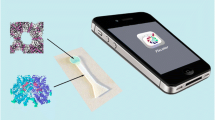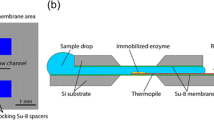Abstract
Ketone bodies (acetoacetate, beta-hydroxybutyrate (βHB), acetone) are generated as a result of fatty acid oxidation in the liver and exist at low concentrations in urine and blood. Elevated concentrations can indicate health problems such as diabetes, childhood hypoglycemia, alcohol, or salicylate poisoning. Development of portable and cost-effective bedside point-of-care (POC) tests to detect such compounds can help to reduce the risk of disease progression. In this study, βHB was chosen as a model molecule for developing an optical sensor–integrated microplatform. Prior to sensor optimization, βHB levels were measured at a concentration range of 0.02 and 0.1 mM spectrophotometrically, which is far below the reported elevated ranges of 1–2 mM and resulting absorbance changes were converted into an Arduino microcontroller code for the correlation. Measurements performed with the designed integrated microplatform were found significant. Integrated microplatform was verified with the benchtop spectrophotometer. Measurements between 0.02 and 0.1 mM substrate concentration were found highly sensitive with “y = 0.7347x + 0.00184” with R2 value of 0.9796, and the limit of detection was determined as 0.02 mM. Based on these results, the proposed system will allow on-site and early intervention.



Similar content being viewed by others
Data Availability
The datasets generated during and/or analyzed during the current study are available from the corresponding author on reasonable request.
Code Availability
Not applicable.
References
Laffel, L. (1999). Ketone bodies: A review of physiology, pathophysiology and application of monitoring to diabetes. Diabetes/metabolism research and reviews, 15(6), 412–426.
Dashti, H. M., & Mathew, T. C. (2009). Prevention of obesity using low carbohydrate ketogenic diet. Kuwait Medical Journal, 41(1), 3–12.
Newman, J. C., & Verdin, E. (2014). β-hydroxybutyrate: Much more than a metabolite. Diabetes Research and Clinical Practice, 106(2), 173–181. https://doi.org/10.1016/j.diabres.2014.08.009.
Robinson, A. M., & Williamson, D. H. (1980). Physiological roles of ketone bodies as substrates and signals in mammalian tissues. Physiological Reviews, 60(1), 143–187. https://doi.org/10.1152/physrev.1980.60.1.143.
Laeger, T., Metges, C. C., & Kuhla, B. (2010). Role of β-hydroxybutyric acid in the central regulation of energy balance. Appetite, 54(3), 450–455. https://doi.org/10.1016/j.appet.2010.04.005.
Lopez-Barbosa, N., Gamarra, J. D., & Osma, J. F. (2016). The future point-of-care detection of disease and its data capture and handling Young Investigators in Analytical and Bioanalytical Science. Analytical and Bioanalytical Chemistry, 408(11), 2827–2837. https://doi.org/10.1007/s00216-015-9249-2.
Chin, C. D., Chin, S. Y., Laksanasopin, T., & Sia, S. K. (2013). Point-of-care diagnostics on a chip. Biological and Medical Physics, Biomedical Engineering, 3–22. https://doi.org/10.1007/978-3-642-29268-2.
Warsinke, A. (2009). Point-of-care testing of proteins. Analytical and Bioanalytical Chemistry, 393(5), 1393–1405. https://doi.org/10.1007/s00216-008-2572-0.
Li, G., Ma, N. Z., & Wang, Y. (2005). A new handheld biosensor for monitoring blood ketones. Sensors and Actuators, B: Chemical, 109(2), 285–290. https://doi.org/10.1016/j.snb.2004.12.060.
Rewers, A., Mcfann, K., & Chase, H. P. (2006). Bedside monitoring of blood β-hydroxybutyrate levels in the management of diabetic ketoacidosis in children. Diabetes Technology and Therapeutics, 8(6), 671–676. https://doi.org/10.1089/dia.2006.8.671.
Wang, C. C., Hennek, J. W., Ainla, A., Kumar, A. A., Lan, W. J., Im, J., Smith, B. S., Zhao, M., & Whitesides, G. M. (2016). A paper-based pop-up electrochemical device for analysis of beta-hydroxybutyrate. Analytical Chemistry, 88(12), 6326–6333. https://doi.org/10.1021/acs.analchem.6b00568.
Klasner, S. A., Price, A. K., Hoeman, K. W., Wilson, R. S., Bell, K. J., & Culbertson, C. T. (2010). Paper-based microfluidic devices for analysis of clinically relevant analytes present in urine and saliva. Analytical and Bioanalytical Chemistry, 397(5), 1821–1829. https://doi.org/10.1007/s00216-010-3718-4.
Kuru, B., Sever, M., Aksay, E., Dogan, T., Yalcin, N., Seker Eren, E., & Ustuner, F. (2014). Comparing finger-stick β-hydroxybutyrate with dipstick urine tests in the detection of ketone bodies. Turkiye Acil Tip Dergisi, 14(2), 47–52. https://doi.org/10.5505/1304.7361.2014.14880.
Guo, J. (2017). Smartphone-powered electrochemical dongle for point-of-care monitoring of blood β-ketone. Analytical Chemistry, 89(17), 8609–8613. https://doi.org/10.1021/acs.analchem.7b02531.
Saygili, E., Orakci, B., Koprulu, M., Demirhan, A., Ilhan-Ayisigi, E., Kilic, Y., & Yesil-Celiktas, O. (2020). Quantitative determination of H2O2 for detection of alanine aminotransferase using thin film electrodes. Analytical Biochemistry, 591(November 2019), 113538. https://doi.org/10.1016/j.ab.2019.113538.
Cheng, J., & Deming, T. J. (2011). Optical detection systems on microfluidic chips. Peptide-Based Materials, 310(September), 1–26. https://doi.org/10.1007/128.
Thiruvengadam, M., Venkidasamy, B., & Subramanian, U. (2020). Up-converting phosphor technology-based lateral fl ow assay for quantitative detection of β -hydroxybutyrate in biological samples. Analytical Biochemistry, 591(December 2019), 113546. https://doi.org/10.1016/j.ab.2019.113546.
Steigert, J., Grumann, M., Brenner, T., Riegger, L., Harter, J., Zengerle, R., & Ducrée, J. (2006). Fully integrated whole blood testing by real-time absorption measurement on a centrifugal platform. Lab on a Chip, 6(8), 1040–1044. https://doi.org/10.1039/b607051p.
Khanfar, M. F., Al-Faqheri, W., & Al-Halhouli, A. (2017). Low cost lab on chip for the colorimetric detection of nitrate in mineral water products. Sensors (Switzerland), 17(10), 1–9. https://doi.org/10.3390/s17102345.
Oscar, S. V., Fernando, O. C. L., & del Pilar, C. M. M. (2017). Total polyphenols content in white wines on a microfluidic flow injection analyzer with embedded optical fibers. Food Chemistry, 221, 1062–1068. https://doi.org/10.1016/j.foodchem.2016.11.055.
Schmidt, O., Bassler, M., Kiesel, P., Knollenberg, C., & Johnson, N. (2007). Fluorescence spectrometer-on-a-fluidic-chip. Lab on a Chip, 7(5), 626–629. https://doi.org/10.1039/b618879f.
Takayama, N., Ohara, T., & Yamamoto, N. (2012). Enzymatic fluorometric microplate assay for quantitative analysis of 3-hydroxybutyric acid in mouse plasma. Analytical Biochemistry, 425(2), 114–116. https://doi.org/10.1016/j.ab.2012.03.011.
Hofmann, O., Miller, P., Sullivan, P., Jones, T. S., Demello, J. C., Bradley, D. D. C., & Demello, A. J. (2005). Thin-film organic photodiodes as integrated detectors for microscale chemiluminescence assays. Sensors and Actuators, B: Chemical, 106(2), 878–884. https://doi.org/10.1016/j.snb.2004.10.005.
Waswa, J., Irudayaraj, J., & DebRoy, C. (2007). Direct detection of E. Coli O157:H7 in selected food systems by a surface plasmon resonance biosensor. LWT - Food Science and Technology, 40(2), 187–192. https://doi.org/10.1016/j.lwt.2005.11.001.
Pires, N. M. M., Dong, T., Hanke, U., & Hoivik, N. (2014). Recent developments in optical detection technologies in lab-on-a-chip devices for biosensing applications. Sensors (Switzerland), 14(8), 15458–15479. https://doi.org/10.3390/s140815458.
Weng, X., Zhao, W., Neethirajan, S., & Duffield, T. (2015). Microfluidic biosensor for β-Hydroxybutyrate (βHBA) determination of subclinical ketosis diagnosis. Journal of Nanobiotechnology, 13(1), 1–8. https://doi.org/10.1186/s12951-015-0076-6.
Sharifi, F., Htwe, S. S., Righi, M., Liu, H., Pietralunga, A., Yesil-Celiktas, O., Maharjan, S., Cha, B. H., Shin, S. R., Dokmeci, M. R., Vrana, N. E., Ghaemmaghami, A. M., Khademhosseini, A., & Zhang, Y. S. (2019). A foreign body response-on-a-chip platform. Advanced Healthcare Materials, 8(4), 1–10. https://doi.org/10.1002/adhm.201801425.
Lam, L. H., Shimamura, T., Manabe, S., Ishiyama, M., & Ukeda, H. (2008). Assay of angiotensin I-converting enzyme-inhibiting activity based on the detection of 3-hydroxybutyrate with water-soluble tetrazolium salt. Analytical Sciences, 24(8), 1057–1060. https://doi.org/10.2116/analsci.24.1057.
Cruces Blanco, C., García Campaña, A. M., & Alés Barrero, F. (1996). Derivative spectrophotometric resolution of mixtures of the food colourants Tartrazine, Amaranth and Curcumin in a micellar medium. Talanta, 43(7), 1019–1027. https://doi.org/10.1016/0039-9140(96)01847-4.
Children Hospitals and Clinics of Minnesota. 2016. https://www.childrensmn.org/references/lab/chemistry/beta-hydroxybutyrate.pdf, 2016 (accessed 29 June 2020).
Iwersen, M., Falkenberg, U., Voigtsberger, R., Forderung, D., & Heuwieser, W. (2009). Evaluation of an electronic cowside test to detect subclinical ketosis in dairy cows. Journal of Dairy Science, 92(6), 2618–2624. https://doi.org/10.3168/jds.2008-1795.
Fang, L., Wang, S. H., & Liu, C. C. (2008). An electrochemical biosensor of the ketone 3-β-hydroxybutyrate for potential diabetic patient management. Sensors and Actuators, B: Chemical, 129(2), 818–825. https://doi.org/10.1016/j.snb.2007.09.066.
Renumadhavi, C. H., Jamuna, N., Chandana, A. N., Balamurali, V., Gupta, P. K., Sheriff, R. S., et al. (2020). Microcontroller-based detection of diabetes and ketosis state using breath sensors. In Recent Trends in Image and Signal Processing in Computer Vision, 1124, 1–17. https://doi.org/10.1007/978-981-15-2740-1_1.
Teshima, N., Li, J., Toda, K., & Dasgupta, P. K. (2005). Determination of acetone in breath. Analytica Chimica Acta, 535(1–2), 189–199. https://doi.org/10.1016/j.aca.2004.12.018.
Weng, X., Chen, L., Neethirajan, S., & Duffield, T. (2015). Development of quantum dots-based biosensor towards on-farm detection of subclinical ketosis. Biosensors and Bioelectronics, 72, 140–147. https://doi.org/10.1016/j.bios.2015.05.008.
Acknowledgements
The authors are grateful to Armagan Ergun for his contributions to PMMA mold production. E.S gratefully acknowledges the TUBITAK 2211-A National Graduate Scholarship Program.
Funding
The study was financially supported by the Scientific and Technological Research Council of Turkey (TUBITAK) 2209/A University Students Research Project Support Program (1919B011800241).
Author information
Authors and Affiliations
Contributions
Utku Devamoglu (U.D.), Irem Duman (I.D.), and Ecem Saygili (E.S.) designed and performed the experiments; U.D., I.D, and E.S wrote the paper; Ozlem Yesil-Celiktas (O.Y.C.) supervised the research and edited the manuscript. All authors read and approved the final manuscript.
Corresponding author
Ethics declarations
Conflict of Interest
The authors declare no competing interests.
Human and Animal Interest
The research does not involve human participants and/or animals.
Additional information
Publisher’s Note
Springer Nature remains neutral with regard to jurisdictional claims in published maps and institutional affiliations.
Supplementary Information
ESM 1
(DOCX 57 kb)
Rights and permissions
About this article
Cite this article
Devamoglu, U., Duman, I., Saygili, E. et al. Development of an Integrated Optical Sensor for Determination of β-Hydroxybutyrate Within the Microplatform. Appl Biochem Biotechnol 193, 2759–2768 (2021). https://doi.org/10.1007/s12010-021-03563-3
Received:
Accepted:
Published:
Issue Date:
DOI: https://doi.org/10.1007/s12010-021-03563-3




